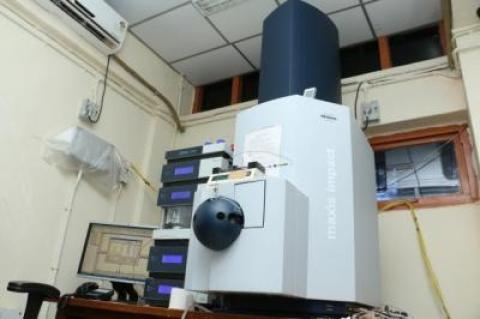
External users: registration to be carried out only through I-STEM portal
Additional information about sample and analysis details should be filled in the pdf form provided in the I-STEM portal under “DOWNLOAD CSRF”
Internal users (IITB): registration to be carried out only through DRONA portal
Additional information about sample and analysis details should be filled in the pdf form provided here.
.
Category
- Spectroscopy and Spectrometry » Mass Spectrometry
Booking Details
Facility Management Team and Location
Facility Features, Working Principle and Specifications
Facility Description
The Bruker maXis Impact is excellent in molecular mass analysis of both known and unknown compound. Machine can provide one step qualitative and quantitative data in a single rapid analysis.
Features:
Sub-ppm mass accuracy and 40,000 FSR full sensitivity resolution.
Extreme sensitivity across the entire mass ranges from very small molecules to intact proteins
High speed MS/MS capabilities with full U-HPLC compatibility.
Simultaneous analysis of major and trace sample components.
Isotopic fidelity for definitive molecular formulae determination.
Robust and easy to operate system
Certainty in identification in combination with Smart Formula 3DTM - unequivocal formula generation with superb mass accuracy.
Better than 0.8 ppm Mass accuracy
Working Principle:
Mass spectrometry is an analytical technique that can provide both qualitative (structure) and quantitative (molecular mass or concentration) information on analyte molecules after their conversion to ions. The molecules of interest are first introduced into the ionization source of the mass spectrometer, where they are first ionized to acquire positive or negative charges. The ions then travel through the mass analyzer and arrive at different parts of the detector according to their mass/charge (m/z) ratio. After the ions make contact with the detector, useable signals are generated and recorded by a computer system. The computer displays the signals graphically as a mass spectrum showing the relative abundance of the signals according to their m/z ratio.
Electrospray ionization mass spectrometry is a desorption ionization method. Desorption ionization methods can be performed on solid or liquid samples and allows for the sample to be nonvolatile or thermally unstable. This means that ionization of samples such as proteins, peptides, oligopeptides, and some inorganic molecules can be performed.
Some technical specifications:
The Bruker maXis Impact is a Hybrid Quadrupole/ Atmospheric pressure ionization orthogonal accelerated Time-of-flight mass spectrometer. The maXis impact is bench-top instrument which includes,
Apollo II Electrospray ion source
APCI II source.
Quadrupole MS/MS Filter
Orthogonal pulsed ion extraction and UHR Time of flight Mass analyzer.
Vacuum system.
Sample Preparation, User Instructions and Precautionary Measures
The sample should be pure and dry and submit in a vial along with the sample code, molecular formula or molecular weight.
Mention the suitable solvent (preferably protonated solvent like MeOH, ACN or water.)
Charges for Analytical Services in Different Categories
| Types Of Analysis | IITB users | Academic institutes | National R&D lab`s | Industries / Non-Govt. Agencies |
| Charges per sample for Accurate Mass (HRMS) | 10 | 750 | 1500 | 3000 |
| Charges for long experiments per sample (LCMS/MSMS) per hour | 200 | 1000 | 2500 | 5000 |
Applications
Proteins/Peptides:
In-depth qualitative analysis of complex samples
Intact mass measurement
Small Molecules:
Identification and characterization
Metabolite analysis:
Targeted and non -targeted approaches
Sample Details
NO
SOP, Lab Policies and Other Details
Publications
--
